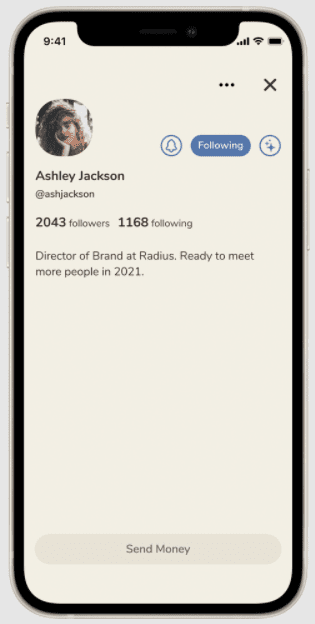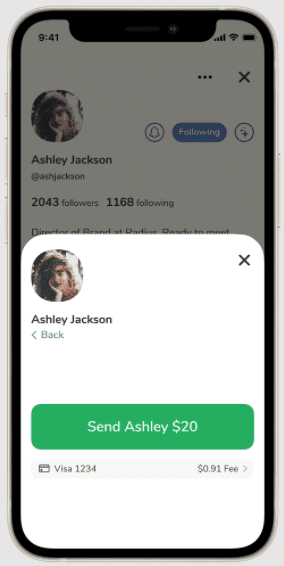Clubhouse is a unique real-time audio app that is quickly gaining a firm foothold in the ultra-competitive world of social media platforms.
Despite the fact that you still technically need an invite to join, its core concept is so appealing that 10 million users have created accounts as of March 2021 — and most of them came on board in Q1 2021.
However, as with any new platform, growing pains abound. Clubhouse’s features are still being fleshed out — including those which benefit creators directly.
On April 5th, 2021, Clubhouse launched Clubhouse Payments, a new feature that gives creators the ability to receive payments from users. Take a look at our comprehensive overview of the new feature, along with specifics regarding how it stacks up against the various payment features available on other more-established social networks.
Rundown of the Clubhouse Payments Feature
As the name suggests, Clubhouse Payments allows any individual to send money to any influencer directly.
Here’s how to do it:
- Go to a creator’s profile page.
- Tap the “+” icon next to the “Following” icon.
- Input the amount of money to send over.
- Add a credit or debit card.
- Tap the Send money button — and you’re done!


Clubhouse creators will receive 100 percent of the funds sent — Clubhouse does not take a cut.
However, Clubhouse also doesn’t want to lose money on Clubhouse Payments — which means that the individual sending the money will be responsible for the credit card processing fees.
Luckily, the fees are reasonable — for example, a $20 payment results in a fee of $0.91.
How Clubhouse Payments Stacks Up Against the Competition
Despite its simplicity, Clubhouse Payments does bring something new into the world of creator monetization. Although almost every other social media platform allows individuals to send money to creators in some form or another, few offer the small-fee structure that Clubhouse Payments does.
Twitch
Twitch offers a myriad of ways to support streamers:
- Bits. Streamers receive $0.01 for every Bit donated. However, Bits cost more than $0.01 to the individual purchasing them. View all of the Bits pricing tiers here.
- Subscriptions. Viewers can subscribe to a Twitch streamer to unlock various features, such as custom emotes. The baseline subscription costs $4.99. However, the streamer receives only 50 percent of the payment.
- Gifted subscriptions. If a viewer is already subscribed to a streamer but wants to help the streamer grow his or her channel further, the viewer can “gift” subscriptions to other viewers. This increases the likelihood that they will come back to support the streamer later on. Costs and fees associated with gifted subscriptions are identical to ordinary subscriptions.
When compared to Bits, Clubhouse Payments is more enticing due to the lower fees. For example, at the time of writing, 100 bits ($1) costs $1.40. The streamer still receives $1, but the individual purchasing the bits also has to pay for Twitch’s markup.
YouTube
Like Twitch, YouTube offers multiple ways to directly support creators:
- Channel memberships. Similar to Twitch subscriptions, channel members unlock a few different perks, such as custom emoji usage and access to members-only community posts.
- Super Chats. These are similar to Bits on Twitch, except instead of buying Bits and spending them on any streamer, Super Chats are localized to one streamer in particular.
For channel memberships, YouTube takes roughly a 30 percent cut.
Super Chats also require a fee from the user. For example, if you make a $10 donation via a Super Chat, at the top of the chat box, a notification showing you donated $10 appears. However, in the backend, YouTube still takes a 30 percent fee from the creator. As such, the $10 figure at the top of the chat box is somewhat misleading.
Like YouTube, Facebook takes up to a 30 percent cut on creator subscriptions.
Facebook also has its own equivalent of Twitch Bits for gaming streamers: Stars. As on Twitch, each Star is worth $0.01 for the creator, and the viewer pays the fee when making the payment. According to the current rates, fees for Stars are about equal to Bits, except at the lower tiers, where Stars are slightly more expensive.
Instagram & Twitter
Currently, Instagram and Twitter do not allow direct payments to creators.
Patreon
Patreon offers low fees — between five and 12 percent. However, Patreon does not integrate directly into any of the popular social media platforms. This means creators are unable to offer perks outside of Patreon for donations made through the platform.
Instead, exclusive subscriber updates are confined to Patreon, meaning subscribers have to specifically check Patreon in order to receive their subscriber benefits, which isn’t ideal due to the extra steps involved.
Custom Payment Solutions
Creators always have the option of receiving donations directly via third-party custom payment services like Venmo. Venmo charges no fees on most transactions, but asking for donations through a third-party app is somewhat clunky, and Venmo offers no platform to provide exclusive updates for subscribers/donators.
The Big Picture
As you can see, in terms of fees, Clubhouse Payments is a significantly more attractive alternative than almost all other direct payment methods available on other social media platforms.
That’s a big deal.
So why isn’t the world abuzz with talk of Clubhouse Payments?
The primary issue is that as of today, Clubhouse Payments offers no other correlating features aside from being able to send money with minimal fees.
For example, a Twitch subscription is an experience, where the subscriber gains a ton of perks in return for their donation. On Clubhouse, you just send money — and that’s it. It’s a lot like Venmo, just without the extra steps of using a third-party service.
Where Clubhouse Payments Fits Into the Clubhouse Ecosystem
Clubhouse currently does not have any publicly available monetization options for creators. In this regard, despite its simplicity, Clubhouse Payments does have the potential to make a real impact. It’s a good first step in making the platform fiscally attractive for influencers. Exposure is great, but if Clubhouse hopes to establish itself as a household name, features that help creators get paid are completely necessary.
We’ll be keeping a close eye on Clubhouse Payments and the overall Clubhouse influencer monetization ecosystem. If they can get it right, we think there’s a good chance of Clubhouse joining the ranks of the other social network behemoths on a long-term timeline.








